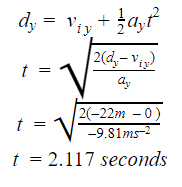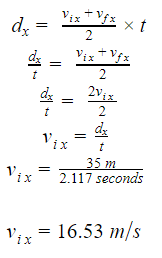Overview
Physics in general can be regarded as the study of how things work and operate in our day to day lives. It can help explain anything as simple as the mechanics and forces involved when you walk to even something as complicated as the origins of the universe. One of the most important and useful applications of physics and kinematics is our ability to predict motion of objects; particularly motion of projectiles. By definition, projectile motion is a type of motion an object undergoes when it’s is launched near the Earth’s surface and travels along a curved path (most commonly a parabolic path).
Methodology for Solving Projectile Motion Questions
- Draw a diagram of the problem given
- Label and include any sort of information given in your diagram (e.g. distances, velocities etc)
- Break the problem into x- and y- components
- Create a table to better organize your data
- Determine which variables you need to solve for and using the appropriate kinematic equations solve for the missing data
Solving a Projectile Motion Question
Question: A soccer ball is kicked horizontally off a 22.0-meter high hill and lands a distance of 35.0 meters from the edge of the hill. Determine the initial horizontal velocity of the soccer ball.
Step #1: Draw and label a detailed diagram
Note: we are taking upwards to be the positive y direction and moving to the right to be the positive horizontal direction
Step #2: Organize all the data into a table
Step #3: Solve for the missing variable using the appropriate kinematic equation
In this question, we are asked to find the initial horizontal velocity therefore, we are looking for vi x. Since we don’t know what the final velocity is in the x direction the only kinematic equation we can apply to the x-components is;
In projectile motion question the time in both the x and y components will always be the same. Hence, for us to solve the equation above we need to find time (t) using the data from the y-component.
Solving for ‘t’ with the data from the y-component we get;
Using the time we just got in the expression previously for the x-component we can now solve for the initial horizontal velocity of the soccer ball.
Therefore, by following these simple steps we found that the soccer ball has an initial horizontal velocity of 16.53 metres/second.









